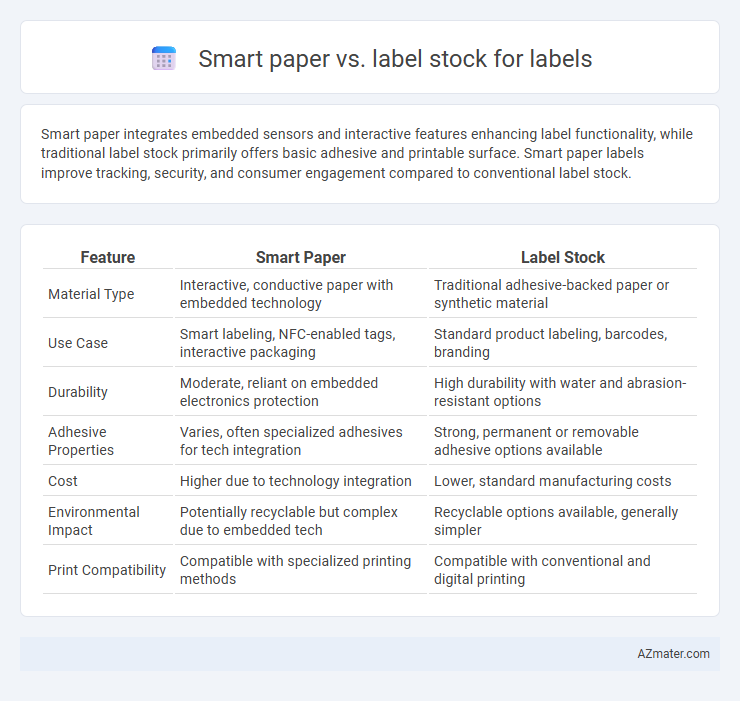Smart paper integrates embedded sensors and interactive features enhancing label functionality, while traditional label stock primarily offers basic adhesive and printable surface. Smart paper labels improve tracking, security, and consumer engagement compared to conventional label stock.
Table of Comparison
| Feature | Smart Paper | Label Stock |
|---|---|---|
| Material Type | Interactive, conductive paper with embedded technology | Traditional adhesive-backed paper or synthetic material |
| Use Case | Smart labeling, NFC-enabled tags, interactive packaging | Standard product labeling, barcodes, branding |
| Durability | Moderate, reliant on embedded electronics protection | High durability with water and abrasion-resistant options |
| Adhesive Properties | Varies, often specialized adhesives for tech integration | Strong, permanent or removable adhesive options available |
| Cost | Higher due to technology integration | Lower, standard manufacturing costs |
| Environmental Impact | Potentially recyclable but complex due to embedded tech | Recyclable options available, generally simpler |
| Print Compatibility | Compatible with specialized printing methods | Compatible with conventional and digital printing |
Introduction to Smart Paper and Label Stock
Smart paper integrates advanced sensors and flexible electronics directly into the substrate, enabling interactive and dynamic labeling solutions for enhanced product tracking and consumer engagement. Label stock comprises traditional materials such as paper or film coated with adhesive, designed primarily for static labeling applications across various industries. Choosing between smart paper and label stock depends on the need for functionality beyond identification, such as real-time data capture and connectivity features.
Key Differences Between Smart Paper and Traditional Label Stock
Smart paper integrates embedded electronics such as RFID or NFC, enabling interactive and dynamic labeling solutions, while traditional label stock consists solely of paper or synthetic materials without connectivity features. Smart paper labels offer enhanced data capture, real-time tracking, and improved inventory management, contrasting with conventional labels that primarily provide static information. The durability and cost of smart paper tend to be higher compared to traditional label stock due to advanced technology integration.
Material Composition and Technology
Smart paper labels utilize advanced silicone or thermal coating on paper substrates that enable direct thermal printing without ribbons, enhancing cost-efficiency and eco-friendliness. Label stock, typically made from synthetic polymers like polypropylene or polyester, integrates adhesive layers and often requires ribbon-based thermal transfer printing for durability and resistance to environmental factors. The technological divergence lies in smart paper's compatibility with heat-sensitive inks for quick, on-demand printing versus label stock's engineered materials for long-lasting, high-resolution image reproduction.
Application Areas in Labeling Industry
Smart paper in labeling is widely used for packaging, retail, and logistics due to its enhanced printability, durability, and resistance to varying environmental conditions. Label stock, consisting of traditional paper or synthetic materials, remains popular in food labeling, product identification, and inventory tracking for its cost-effectiveness and versatility. Industries such as pharmaceuticals and electronics prefer smart paper for compliance labeling and tamper-evident applications, while label stock is favored in high-volume consumer goods labeling.
Performance and Durability Comparison
Smart paper labels offer enhanced print quality and faster processing speeds, making them ideal for high-volume applications requiring clear, sharp images and text. Label stocks, often composed of synthetic materials like polypropylene or polyester, provide superior durability against moisture, chemicals, and abrasion, ensuring long-lasting performance in harsh environments. The choice between smart paper and label stock depends on the need for print precision versus environmental resistance, with synthetic label stocks excelling in longevity and smart paper optimizing cost-effective, high-resolution output.
Cost Analysis: Smart Paper vs Label Stock
Smart paper typically offers lower upfront costs compared to traditional label stock, as it requires less material and simpler printing technology, reducing overall production expenses. Label stock involves higher material costs and often requires specialized adhesives and coatings, increasing both purchase and waste expenses during labeling processes. For large-scale labeling operations, smart paper can provide significant cost efficiencies in terms of raw materials and operational flexibility, whereas label stock may incur higher consistent costs due to its durable qualities and specific application demands.
Environmental Impact and Sustainability
Smart paper for labels incorporates embedded sensors and electronic components, increasing resource consumption and electronic waste compared to traditional label stock. Label stock typically uses recyclable materials such as paper or film without embedded electronics, making it more environmentally sustainable due to easier recycling and lower production emissions. Choosing label stock over smart paper significantly reduces ecological footprint, supports circular economy initiatives, and decreases landfill impact.
Printing Compatibility and Flexibility
Smart paper offers advanced printing compatibility with various digital printers, including thermal, inkjet, and laser, providing versatility for high-resolution and variable data printing. Label stock, typically designed for specific printing technologies like thermal transfer or direct thermal, may limit flexibility but ensures optimal print quality and durability for targeted applications. Choosing between smart paper and label stock depends on the required printing method compatibility and the desired balance between flexibility and specialized print performance.
Market Trends and Future Outlook
The global market for smart paper and label stock is experiencing rapid growth driven by increased demand for advanced tracking and branding solutions in retail and logistics sectors. Innovations such as RFID-enabled smart paper and eco-friendly label stock are shaping the future landscape, with smart labels projected to capture a significant market share due to enhanced functionality and cost-efficiency. Industry forecasts predict sustained growth aligned with digital transformation trends, enabling real-time data capture and improved supply chain visibility.
Choosing the Right Option for Your Labeling Needs
Smart paper offers high print quality and durability, ideal for labels requiring clear graphics and longevity, while label stock provides versatility with various adhesive strengths suited for different surfaces. Selecting the right material depends on factors such as environmental exposure, surface compatibility, and budget constraints to ensure optimal label performance. Assessing your specific application requirements, including print technology and label lifespan, helps determine whether smart paper or label stock best meets your labeling needs.

Infographic: Smart paper vs Label stock for Label
 azmater.com
azmater.com